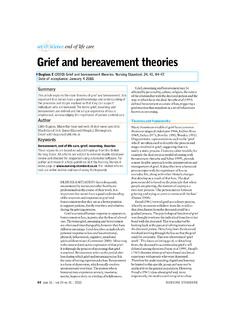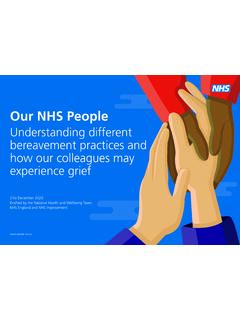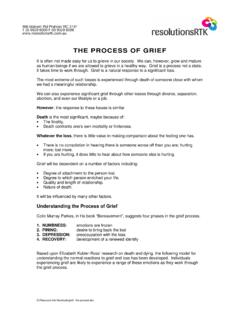Transcription of How to Facilitate a Grief Group - Heart House Hospice
1 How to Facilitate a Grief Group ACKNOWLEDGMENTS. This book was written with the financial support of the Ontario Trillium Foundation (OTF), with the objective of building compassionate communities and empowering communities and organizations to provide well informed support to people living with Grief . It is a project of Heart House Hospice (HHH). Heart House Hospice provides palliative and bereavement services in the Region of Peel. Today, HHH serves over 1,000 individuals living with life limiting illness, and thousands of family members and loved ones in Mississauga and Brampton, offering services that are valued by our community and our health care partners. This guide has been prepared based on my experience running bereavement groups at HHH. My background as a counselor and a workshop facilitator working in a variety of health care settings has also informed this book. Thank you to Jodi Pereira, Peggy Moore, Samantha Gajindranauth, and Deepak Ramachandran for comments, research and editing support.
2 HHH Grief Model Organizations that provide bereavement support benefit from the work of Grief theorists and bereavement professionals working to create safe spaces for participants to do the hard work of mourning. Much of the programming at HHH is grounded in the expertise of author, educator and Grief counsellor Dr. Alan D. Wolfelt. His guide, understanding Your Grief - Support Group Guide, and his book, understanding Your Grief Ten Essential Touchstones for Finding Hope and Healing Your Heart , were two resources used in creating this guide, listed in the appendix. HHH (like Wolfelt) takes a companioning model in providing Grief support. This approach is less about being an expert , and more about the willingness to be present with another's pain. It is about helping others to discover or reclaim inner and outer resources. It involves listening more than directing; and walking alongside, not fixing.
3 When grievers enter the unknown territory of Grief , and work to integrate the reality of the death of a loved one, they are forever changed. In a Grief support Group , both participant and facilitator must be willing to undergo that transformation. Using this Guide This guide is written for those who, while not certified Grief therapists or regulated professionals, feel called to work with grieving and/or bereaved people. Whether planning to Facilitate a Group as a volunteer, as a student or professional-in-training, or because of your own personal life experience with loss and Grief , you know how important it is to find validation, companionship and a sense of belonging at this most vulnerable time in a person's life. Companioning is about supporting people, through acceptance of the pain of loss, to come to a renewed sense of hope, meaning and purpose. Ultimately, HHH believes that community is at the Heart of healing.
4 We hope this booklet aids you in your efforts to build compassion within your community. Alexandra Horsky Heart House Hospice Mississauga, Ontario February, 2020. TABLE OF CONTENTS. SECTION 1. A POWERFUL METHOD FOR HELPING WITH Grief 3. WHY RUN Grief GROUPS? 3. SECTION 2. HOW Grief GROUPS WORK 4. THE SIX NEEDS OF MOURNING 4. THE SUPPORT Group 'S 5 DEVELOPMENTAL STAGES 5. Phase 1: Warm-up; establish Group purpose and limits 5. Phase 2: Tentative self-disclosure and exploring Group boundaries 5. Phase 3: In-depth self-exploration and encountering the pain of Grief 6. Phase 4: Commitment to continued healing and growth 6. Phase 5: Preparation for and leaving the Group 7. SECTION 3. DESIGNING A Grief Group 7. SHOULD YOU CREATE A Grief Group ? 7. OPEN AND CLOSED BEREAVEMENT GROUPS 7. Open groups 7. Closed groups 7. Common themes 8. THE STRUCTURE OF GROUPS 8. THE FACILITATOR 8. SIZE OF Group 9. TIME OF DAY TO OFFER Group AND FOR HOW LONG 9.
5 SESSION TOPICS 9. SECTION 4. MARKETING AND LOGISTICS 10. MARKETING: GETTING THE WORD OUT 10. LOCATION 10. MATERIALS 11. SECTION 5. RUNNING THE Group 11. WELCOMING & SCREENING PARTICIPANTS 11. SESSION STRUCTURE 11. Group GUIDELINES 12. Sample Guidelines / Ground Rules 12. EVALUATING THE Group 13. Sample Evaluation Questions 13. SECTION 6. TROUBLE-SHOOTING 14. POTENTIAL TROUBLE SPOTS 14. RED FLAGS 15. SECTION 7. FACILITATOR SELF-CARE 16. SECTION 8. PUTTING IT ALL TOGETHER 17. APPENDIX 18. 3. SECTION 1. A POWERFUL METHOD FOR HELPING WITH Grief . WHY RUN Grief GROUPS? Bereavement groups can provide many benefits to grieving people. They can: Help to normalize the intense impacts of Grief Provide a safe, non-judgmental space for the griever to share his/her thoughts, emotions and struggles Provide a venue to grapple with changes in identity, roles and relationships Enable the participant to discover and develop inner and outer resources and learn coping strategies Encourage grievers to ask for and receive support, understanding and compassion, and to offer support to others Help participants learn new ways of problem-solving from peers Help participants learn about self-acceptance, self-care, self-compassion and resilience.
6 Support participants to search for meaning and purpose in life without the presence of their loved one Support members to accept and integrate the reality of the loss, embracing the pain in doses . Protect against isolation and shame in a mourning-avoiding culture Help to build compassionate communities Grief groups can be a positive, rewarding program for an organization, and a powerful component of a counselor's private practice. Groups are a timely and cost-effective way to help multiple people. In addition, they offer facilitators and organizations the opportunity to learn about and respond to community need. For example, Heart House learned from bereavement Group participants about the need for social programs for bereaved people, and subsequently started a social walking Group . If you have any questions or suggestions for improvement to this guide, please email Please use the subject line How to Run a Grief Group to ensure your comments reach the right people at HHH.
7 4. SECTION 2. HOW Grief GROUPS WORK. As you plan, prepare for and run your Grief Group , it can be helpful to remember the basic needs of mourning, which are well described in a number of books and resources (see Appendix). According to Alan Wolfelt, an experienced Grief expert, mourners have 6 central needs: THE SIX NEEDS OF MOURNING. Adapted from Alan Wolfelt, understanding Your Grief : 10 Essential Touchstones for Finding Hope and Healing Your Heart . NEED 1 | Acknowledge the Reality of the Death The bereavement Group will allow mourners to gently confront the reality that someone they loved has died and will not return. The Group will provide an opportunity for members to tell their stories, and to move from head to Heart in embracing the reality and impact of the death. NEED 2 | Move Toward the Pain of the Loss Bereaved people need to find a balanced approach to Grief , moving both toward and away from Grief .
8 The Grief Group is one place members are encouraged to move toward their Grief , exploring the broad range of thoughts and feelings that accompany loss. NEED 3 | Remember the Person Who Died Grief theorists are shifting the dialogue from ideas about closure and moving on from Grief , to the idea of continued bonds with the person who died. Mourners are encouraged to discover a different kind of relationship with the person who died one that is based on precious memories, the presence of objects and photos that recall the person who died, conversations about dreams and legacies the bereaved person hopes to continue in his/her loved one's honour, letters or journal entries written to the deceased, and so on. NEED 4 | Develop a New Self-Identity With a significant loss, come changes in self-identity and the role a person plays in life. Grief Group participants may have gone from being wives/husband to widows or widowers, or parents to bereaved parents, etc.
9 Support groups help meet this need by allowing members to talk out their thoughts on these identity changes and explore the adjustment with others in similar situations. NEED 5 | Search For Meaning It is common for Group members to struggle with why? questions about death: why did this happen? Why now? Why in this way? Bereavement groups provide a safe, non-judgmental place in which to ask these questions, and make meaning of the loss. Participants may also broaden the question from why? to how? ( how can I best care for myself ?), or where from here? ( how will I create new purposes?). NEED 6 | Continue to Receive Support From Others Grief is an ongoing process that unfolds over the course of many years. Sometimes participants express a desire to continue to meet after the sessions are complete. Continuing as a Group can take many forms such as continued emotional support, meeting for meals or coffee, or pursuing activities of interest (yoga, book club, for example).
10 Some groups do not wish to continue together and may benefit from a list of community supports for social and recreation activities. It is helpful to distribute a list of community supports for people in Grief , as well as those that are more social or recreational in nature. 5. THE SUPPORT Group 'S 5 DEVELOPMENTAL STAGES. Adapted from Alan Wolfelt, understanding Your Grief : Support Group Guide: Starting and Leading a Bereavement Support Group . As a facilitator, you can expect a Grief Group to move through five phases. A facilitator does not normally discuss the stages explicitly with Group members; however, they are useful for the facilitator to keep in mind, particularly if a Group seems stuck. In this case, it may be helpful to reflect on the possibility that some Group members might feel a lack of safety or trust. In the majority of situations, the process unfolds organically. Groups can straddle more than one phase at a time, as the stages naturally overlap, and each Group will spend more or less time in these phases depending on their make-up.



